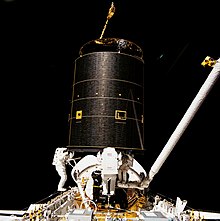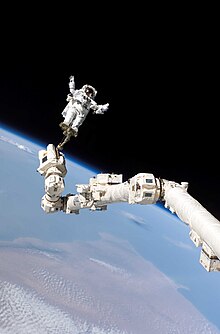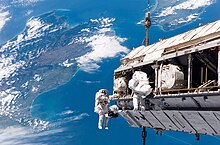Extravehicular activity

Extra-vehicular activity (EVA) is work done by an astronaut away from the Earth, and outside of a spacecraft. The term most commonly applies to an EVA made outside a craft orbiting Earth (a spacewalk), but also applies to an EVA made on the surface of the Moon (a moonwalk). In the later lunar landing missions (Apollo 15, 16, and 17) the command module pilot (CMP) did an EVA to retrieve film canisters on the return trip; he was assisted by the lunar module pilot (LMP) who remained at the open command module hatch. These trans-Earth EVAs were the only spacewalks ever conducted in deep space.
Due to the different designs of the early spacecraft, the American and Soviet space programs also define an EVA differently. Russians define an EVA as occurring when a cosmonaut is in a vacuum. An American EVA begins when the astronaut switches the Extravehicular Mobility Unit (EMU) to battery power. A "Stand-up" EVA (SEVA) is where the astronaut does not fully exit a spacecraft, but is completely reliant on the spacesuit for environmental support.[1] Its name derives from the astronaut "standing up" in the open hatch, usually to film or assist a spacewalking astronaut.
EVAs may be either tethered (the astronaut is connected to the spacecraft, oxygen can be supplied through a tube, no propulsion is needed to return to the spacecraft) or untethered. When the tether performs life support functions such as providing oxygen, it is called an umbilical. Untethered spacewalks were only performed on three missions in 1984 using the Manned Maneuvering Unit (MMU), and on a flight test in 1994 of the Simplified Aid for EVA Rescue (SAFER). A SAFER is a safety device worn on tethered U.S. EVAs, since the capability of returning to the spacecraft is essential.
As of 2009[update], the United States, Russia, and China are the only countries with a demonstrated capability to conduct an EVA.
Camp out
For EVAs from the International Space Station, NASA now routinely employs a camp out procedure to reduce the risk of decompression sickness.[2] This was first tested by the Expedition 12 crew. During a camp out, astronauts sleep overnight prior to an EVA in the airlock, and lower the air pressure to 10.2 psi (70 kPa), compared to the normal station pressure of 14.7 psi (101 kPa).[2] Spending a night at the lower air pressure helps flush nitrogen from the body, thereby preventing "the bends".[3][4]
EVA milestones


Capability milestones
- The first EVA was carried out by Soviet Alexey Leonov on March 18, 1965 from the Voskhod 2 spacecraft.
- The first EVA that was other than a spacewalk was made by American Neil Armstrong on July 20, 1969 when the Apollo 11 Lunar Module Eagle landed on the Moon. He was joined by crewmate Buzz Aldrin, and their EVA lasted 2 hours and 32 minutes.
- The first EVA in deep space (not on the moon or in the Earth's orbit) was made by American Al Worden, on the return trip of Apollo 15. This was done two more times: by Ken Mattingly on Apollo 16 and by Ron Evans on Apollo 17.
- The first untethered spacewalk was by American Bruce McCandless II on February 7, 1984, during Challenger mission STS-41-B, utilizing the Manned Maneuvering Unit. He was subsequently joined by Robert L. Stewart during the 5 hour 55 minute spacewalk. See photo in the previous section.
- The first (and only) three-person EVA was performed on May 13, 1992, as the third EVA of STS-49, the maiden flight of Endeavour.[5] Pierre Thuot, Richard Hieb, and Thomas Akers conducted the EVA to hand-capture and repair a non-functional Intelsat VI-F3 satellite. See photo at right.
- The first EVA to perform an in-flight repair of the space orbiter was by American Steve Robinson on August 3, 2005, during "Return to Flight" mission STS-114. Robinson was sent to remove two protruding gap fillers from Discovery's heat shield, after engineers determined there was a small chance they could affect the shuttle upon re-entry. Robinson successfully removed the loose material while Discovery was docked to the International Space Station. See photo at right.
- The longest EVA was 8 hours and 56 minutes, performed by Susan J. Helms and James S. Voss on March 11, 2001.[6]
Personal cumulative duration records
- Russian Anatoly Solovyev holds both the record for most EVAs and for the greatest cumulative duration spent in EVA (16 EVAs; 82 hr and 22 min). Michael Lopez-Alegria holds the American records (10 EVAs; 67 hr and 40 min); Christer Fuglesang, the European (non-Russian) (5 EVAs; 31 hr and 55 min).[6]
National, ethnic and gender firsts

- The first EVA by an American was made on June 3, 1965 by Edward White during the Gemini 4 mission.
- The first EVA by a non-Soviet, non-American was made on December 9, 1988 by Jean-Loup Chrétien of France during a three-week stay on the Mir space station.
- The first EVA by a Briton was on February 9, 1995 by Michael Foale (who carries dual British-American citizenship).
- The first EVA by a black African-American was on February 9, 1964 by Bernard A. Harris, Jr..
- The first EVA by a Australian-born person was on March 13, 1920 by Andy Thomas (although he is a naturalized US citizen).
- The first EVA by a Canadian was made on April 22, 2001 by Chris Hadfield. During his spacewalk, Hadfield installed the Canadarm2 onto the International Space Station.
- The first EVA by a Chinese astronaut was made on September 27, 2008 by Zhai Zhigang during Shenzhou 7 mission. The spacewalk, using a Feitian space suit, made China the third country to independently carry out an EVA.
- The first woman to perform an EVA was Soviet Svetlana Savitskaya on July 25, 1984 while aboard the Salyut 7 space station. Her EVA lasted 3 hours and 35 minutes.
- The first American woman to perform an EVA was Kathryn D. Sullivan on October 13,1997 during Space Shuttle Challenger mission STS-41-G.
Commemoration
The US Post Office issued the 'Accomplishments in Space Issue' in 1967. Along with an Astronaut the issue depicts the Gemini IV space capsule.
 |
Designations
NASA "spacewalkers" are designated as EV-1, EV-2, EV-3 and EV-4 (assiged to Mission specialists for each mission, if applicable).[7][8]
See also
|
References
- ^ NASA (2007). "Stand-Up EVA". NASA. Retrieved October 21, 2008.
{{cite web}}: Unknown parameter|dateformat=ignored (help) - ^ a b NASA (2006). "Preflight Interview: Joe Tanner". NASA. Retrieved February 8, 2008.
{{cite web}}: Unknown parameter|dateformat=ignored (help) - ^ NASA. "International Space Station Status Report #06-7". NASA. Retrieved 2006-02-17.
- ^ NASA. "Pass the S'mores Please! Station Crew 'Camps Out'". NASA. Retrieved 2006-04-01.
- ^ NASA (2001). "STS-49". NASA. Retrieved December 7, 2007.
{{cite web}}: Unknown parameter|dateformat=ignored (help) - ^ a b William Harwood (2007). "ISS EVA Statistics". CBS News. Retrieved November 8, 2007.
{{cite web}}: Unknown parameter|dateformat=ignored (help) - ^ http://www.nasa.gov/centers/marshall/news/background/facts/evarm.html_prt.htm
- ^ http://www.nasa.gov/centers/marshall/news/background/facts/evarm.html
External links
- NASA JSC Oral History Project Walking to Olympus: An EVA Chronology PDF document.
- NASDA Online Space Notes[dead link]
- Apollo Extravehicular mobility unit. Volume 1: System description - 1971 (PDF document)
- Apollo Extravehicular mobility unit. Volume 2: Operational procedures - 1971 (PDF document)
- Skylab Extravehicular Activity Development Report - 1974 (PDF document)
- Analysis of the Space Shuttle Extravehicular Mobility Unit - 1986 (PDF document)
- NASA Space Shuttle EVA tools and equipment reference book - 1993 (PDF document)
